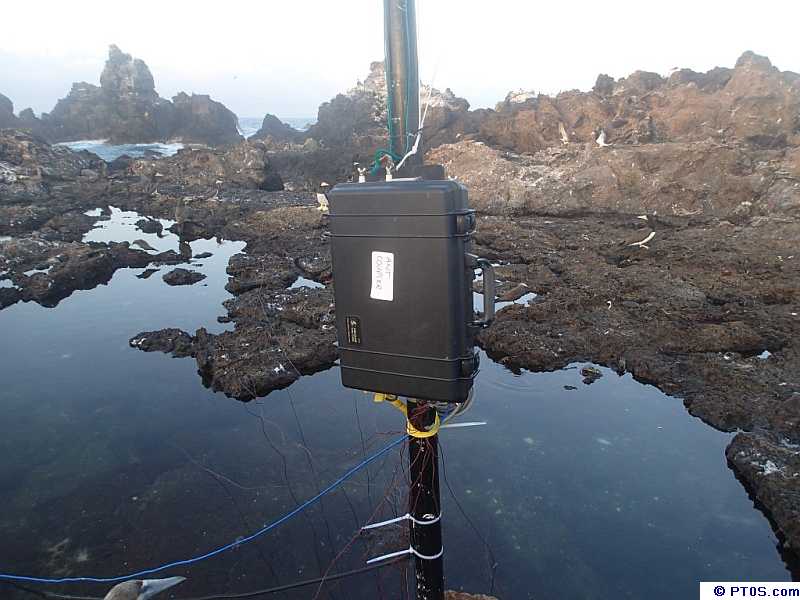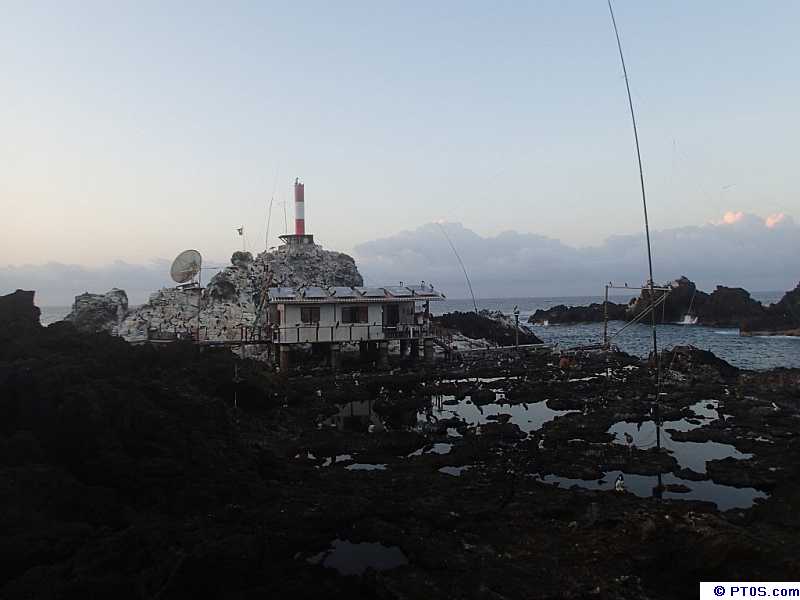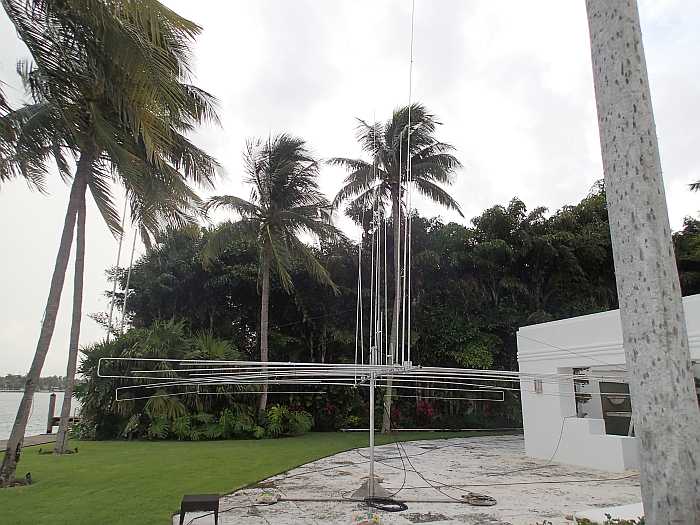
 |
news | about | equipment | LOG search | QSL info | photos | support |  |
EQUIPMENT

PT0S Antenna Layout

The antenna coupler at the base of the 80-10 vertical. Note the "radials": all going is the same direction. They were originally laid out all around bug got swept by the strong current at high tide. As the actual ground was provided by the salt water under the antenna, this had no noticeable effect. Indeed, the job of these "radials" was just to just couple the ground current into the salt water. Also note the dual output on the coupler and the two antenna wires: the green wires (3 of them to reduce losses and to make the antenna electrically "fatter") go all the way to the top of the 18 m tall mast. This section was used on 80-30 meters. The white wire, which forms a 6x2x5 m triangle, was used on 20-10 meters. While the coupler could tune the longer wire on the higher bands, the longer wire has a higher radiation angle then the shorter triangle and was more suitable for long distance DX. In practice, we noticed little difference, but that may be because the antenna was standing in a shallow crater and the shorter wire section may have been obscured somewhat by the surrounding rocks. Despite all that, this was probably our best performing antenna. It is worth taking a note of this: The antenna stands in salt water at the lowest point, instead of the nearby peak, which many would consider to be the ideal position for such an antenna. It isn't!


Transport:
We will travel from the city of Natal aboard a Brazilian fishing vessel. The distance is 550 nautical miles (990 km) which is a four day trip. Cargo capacity is limited and these fishing vessels are not overly comfortable.
TX Antennas: There will be three TX antennas: Two SpiderPole based verticals, each fed by an antenna coupler, and the newly developed Garden Beam, a rotatable tri-band vertical parasitic array. Conditions on Belmont do not allow for the installation of antennas with large footprints and we must be sensitive to the environmentally critical nature of the rocks, therefore the use of simple and light antennas. The main TX antenna, intended for 160, 80 and 40 meters, will be an inverted L, mounted on the edge of the rocks on the northernmost tip of Belmont, about 3 meters above the water's edge. Grounding will mostly be through the salt-water. The antenna will be fed via a high power automatic antenna coupler, similar to the one used on our previous DXpedition. A second vertical, to be used on 80, 40 and 30 meters, will be located on the east side of Belmont, approximately 50 meters from the main TX antenna.

The new 3 Element Tri-Band Garden Beam is undergoing testing at AA7JV's QTH.
This antenna will give us beam performance without the need for a tower. The antenna covers 20, 15 and 10 meters.
The Garden Beam, which covers 20, 15 and 10 meters, will be located on a small stand 2 meters above the rocks. The GB is a unique vertically polarized antenna that provides substantial gain and front-to-back even when mounted low above the ground. Unlike a regular Yagi, which must be mounted high above the ground for low angle radiation, the GB achieves low angles even when mounted very close to the ground. This eliminates the need for a tower or mast. For details go to : http://gardenbeam.com/

Predicted 20 m horizontal radiation pattern of the GB mounted 2.5 m above the rocks. Note the low take-off angle -- thanks to the salt water around. Test results at AA7JV's QTH, with the antenna mounted 7 meters from the water's edge, closely follow the predictions.
RX Antennas:
Because of the lack of space on Belmonte, we will install two remotely controlled small DHDL antennas, and their associated filters and pre-amplifiers, on a rock named Cabral, about 70 meters north of the main TX antenna. The coax and control cables will run underwater to Belmont. We hope that this arrangement will allow us to operate simultaneously on two bands, especially on 160 and 80 meters, without compromising our low-band RX capability. A description of the DOUBLE HALF DELTA LOOP antenna used by TX3A can be downloaded from the following URL: https://dxexpeditions.com/tx3a//docs/TX3A_DOUBLE_HALF_DELTA_LOOP.ZIP
Transceivers and Amplifiers:
We will have two stations. Both stations will use K3 transceivers. The main station will have two combined SG-500 amplifiers for an output of 1000 W, while the other station will have a single SG-500 amplifier for an output of 500 watts.
AC Power:
Two 240 V, 1.5 kW Honda generators will provide AC power. All radios and amplifiers will run on 12 V DC. There will be two battery banks: two paralleled 12 Volt 60 Ahr car batteries for the transceivers and six paralleled batteries for the power amplifiers. The batteries will be continuously replenished via two 80 A battery chargers. This arrangement, which we have tested and refined on VK9GMW and TX3A, provides the most efficient use of the generators, as the batteries act as buffers, allowing the generators to run in their Eco mode most of the time. This will be critical, as our allowable fuel load is only 400 liters, which works out to around 28 liters (or 7 gallons) per day, for a 14 day operation. Fuel efficiency will be key to being able to use full power during the entire operation. Also, by being very fuel efficient, we will be complying with the mandate to be extremely environmentally friendly, and bring a minimum impact to this sensitive area.
